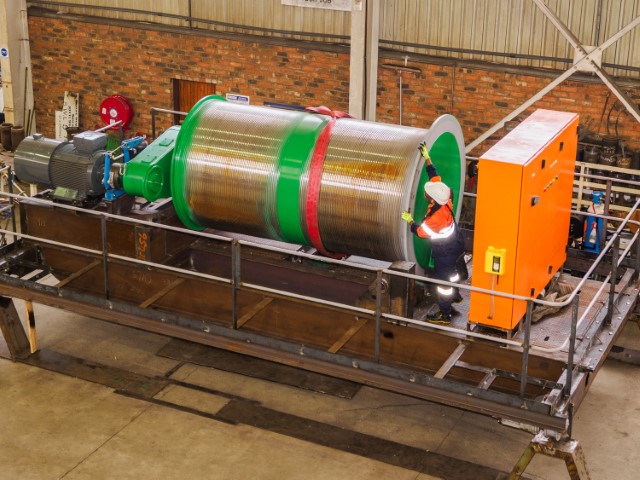Condra’s design team wins through
PROBLEM SOLVED – I

Double bogeys fitted to the end-carriages of this overhead crane represent the key to a puzzle recently solved by Condra: how to meet customer specifications while still being able to install the completed crane in a factory with no roof access and insufficient headroom. Conventional installation of a crane of this type is usually executed by first lifting the disconnected end-carriages onto the gantry, then attaching the girders to form the frame of the crane, and finally lowering the crab and hoist into position from above.
The problem in this case is there is not enough factory headroom to do that, even though the crane has already been designed with a lowered profile to achieve maximum lifting height.
Condra’s solution was to fit bogeys to each end of both 12-metre-span steel girders, four bogeys in all, and to develop a different installation sequence. By fitting the girders with bogeys, an additional 20 millimetres of headroom is freed up through reduced wheel loading and consequent smaller diameter wheels.
Integral bogeys also allow the girders to be placed on the factory gantry as the first step of installation. The girders will be moved apart and the hoist lifted into position between them, instead of being lowered into position from above. The girders will then be closed up and their bogeys linked and fixed, resulting in two double-bogey end-carriages and a completed overhead crane.
Condra specialists will carry out this installation at the customer’s Johannesburg factory this month (April).
PROBLEM SOLVED — II

The unusually large rope drum on this hoist, seen here nearing completion at Condra’s Germiston factory, has been designed to hold and manage nearly 700 metres of rope, winding and unwinding it at high speed during very high lifts of 150 metres within a narrower-than-normal mineshaft. Careful calculation of rope drum dimensions and winding sequence was the focus of the drum’s design.
Drum PCD (pitch-circle-diameter) is 1600mm. A 4:2 centre-lift reeving arrangement will avoid snagging the mineshaft sides.
The drum will carry 676 metres of 18mm rope, lifting and lowering loads at 30 metres per minute, almost ten times faster than lifts in standard overhead crane workshop applications.
Condra’s design team had to coordinate the drum width with a PCD and reeving arrangement that will precisely control and restrict lateral movement of the four ropes moving vertically as they lift or lower the load. The rope will wind onto or unwind from the drum in opposite directions as the drum rotates.
The hoist features improved drives, gearboxes and safety devices, and enhanced operation by remote control. Motor design is such that the load placed on the electric motor will remain manageable despite the non-stop nature of the work at the mineshaft.
Crab span is 6972mm with a wheelbase of 3400mm. Crab and hoist disassemble to fit into a standard 12-metre shipping container.

Double bogeys fitted to the end-carriages of this overhead crane represent the key to a puzzle recently solved by Condra: how to meet customer specifications while still being able to install the completed crane in a factory with no roof access and insufficient headroom. Conventional installation of a crane of this type is usually executed by first lifting the disconnected end-carriages onto the gantry, then attaching the girders to form the frame of the crane, and finally lowering the crab and hoist into position from above.
The problem in this case is there is not enough factory headroom to do that, even though the crane has already been designed with a lowered profile to achieve maximum lifting height.
Condra’s solution was to fit bogeys to each end of both 12-metre-span steel girders, four bogeys in all, and to develop a different installation sequence. By fitting the girders with bogeys, an additional 20 millimetres of headroom is freed up through reduced wheel loading and consequent smaller diameter wheels.
Integral bogeys also allow the girders to be placed on the factory gantry as the first step of installation. The girders will be moved apart and the hoist lifted into position between them, instead of being lowered into position from above. The girders will then be closed up and their bogeys linked and fixed, resulting in two double-bogey end-carriages and a completed overhead crane.
Condra specialists will carry out this installation at the customer’s Johannesburg factory this month (April).
PROBLEM SOLVED — II

The unusually large rope drum on this hoist, seen here nearing completion at Condra’s Germiston factory, has been designed to hold and manage nearly 700 metres of rope, winding and unwinding it at high speed during very high lifts of 150 metres within a narrower-than-normal mineshaft. Careful calculation of rope drum dimensions and winding sequence was the focus of the drum’s design.
Drum PCD (pitch-circle-diameter) is 1600mm. A 4:2 centre-lift reeving arrangement will avoid snagging the mineshaft sides.
The drum will carry 676 metres of 18mm rope, lifting and lowering loads at 30 metres per minute, almost ten times faster than lifts in standard overhead crane workshop applications.
Condra’s design team had to coordinate the drum width with a PCD and reeving arrangement that will precisely control and restrict lateral movement of the four ropes moving vertically as they lift or lower the load. The rope will wind onto or unwind from the drum in opposite directions as the drum rotates.
The hoist features improved drives, gearboxes and safety devices, and enhanced operation by remote control. Motor design is such that the load placed on the electric motor will remain manageable despite the non-stop nature of the work at the mineshaft.
Crab span is 6972mm with a wheelbase of 3400mm. Crab and hoist disassemble to fit into a standard 12-metre shipping container.
